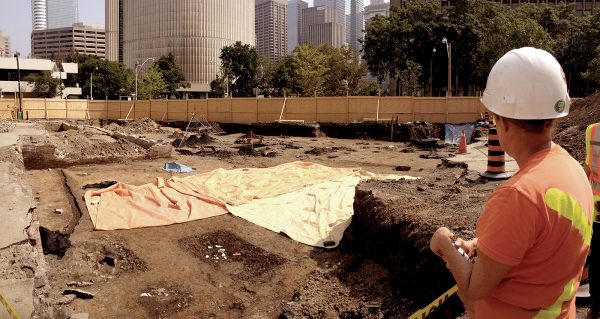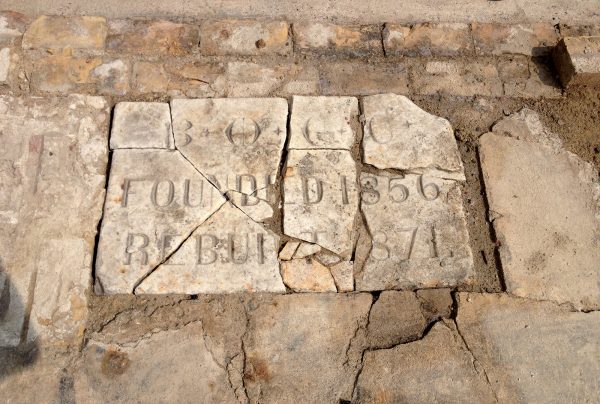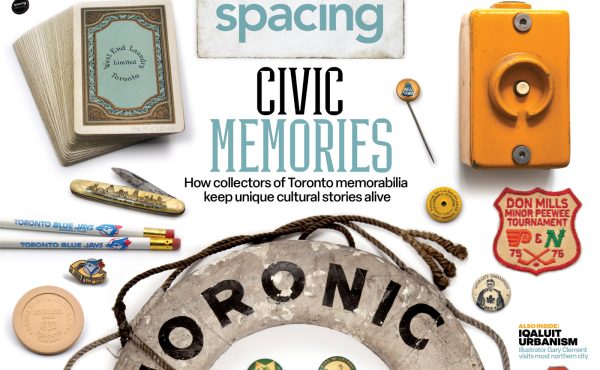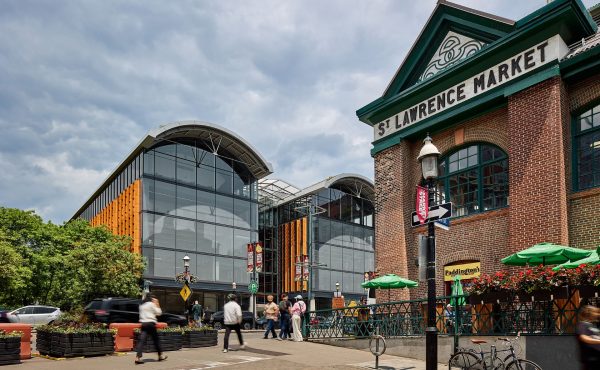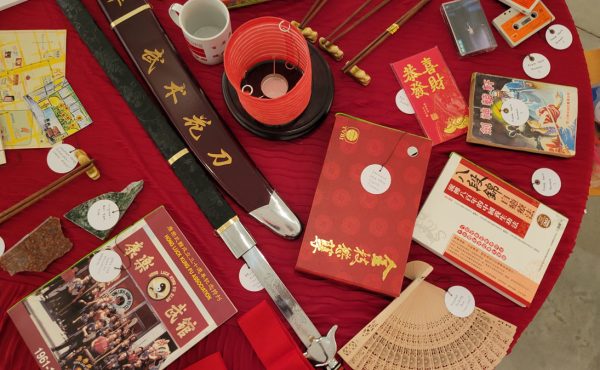For almost six months last year, an archaeological crew meticulously unearthed the treasures that had lain hidden beneath the Centre Ave. parking lot, near City Hall, for decades.
As the archaeologists discovered, the lot — which will become a major new provincial court house — contained thousands of artifacts, dozens of privy pits and the foundations of several buildings of distinct historical significance, including 19th century working class row houses, a synagogue, several small factories, and the foundation of the British Methodist Episcopal Church (BME). An extended feature about the dig can be found in the spring issue of Spacing.
A small wood-frame church, which originally belonged to the African Methodist Episcopal denomination, was established on the site in mid-1840s by five African Americans who had fled slavery, traveled to Canada via the Underground Railroad, and purchased the land from John Beverley Robinson, Upper Canada’s first chief justice. The BME, as the church came to be known in 1856, expanded at least twice as the congregation and community grew, serving as an important community hub for abolitionist groups and black self-help organizations assisting refugees arriving to Toronto before and during the American Civil War. It was demolished in the late 1980s.
In two weeks, Toronto and East York community council will get its first look at a preliminary staff report outlining the City’s response to Infrastructure Ontario’s development proposal for the courthouse. That report, among other things, will mark the beginning of an effort by the City to address the question of how these two governments should treat those parking lot discoveries, and the opportunities — for community engagement, historical interpretation/commemoration and place-making — they afford.
Alongside the City’s recommendations, Infrastructure Ontario has retained ERA Architects to develop ideas for an interpretation plan for the site in consultation with a stakeholder group that’s been meeting for several months.
All this will be up for discussion tonight at Innis College, which is hosting a slide show by the consulting archaeologist Holly Martelle and a panel discussion that includes ERA’s Michael McClelland and local councilor Kristyn Wong-Tam. (Full disclosure: I co-edited The Ward with McClelland, ERA heritage writer Tatum Taylor, and archivist-historian Ellen Scheinberg, who is also on the panel.)
Thirty years ago, historian archaeologist Karolyn Smardz Frost led an effort to excavate the remnants of the Eastern Ave. home of Thornton and Lucie Blackburn, who fled Kentucky and escaped to Canada in the 1820s, where Thornton became Toronto’s first cab operator and later a prosperous landowner. The excavation was a much-publicized project; the site is marked by a plaque, which remains (as far as I know) the only public space acknowledgment of Toronto’s role in the Underground Railroad.
For the most part, however, Toronto hasn’t done a very good job with protecting other elements of its hidden heritage, although there have been marked improvements in recent years with the development of an archaeological master plan. While a handful of new-ish developments incorporate archaeological remnants unearthed prior to construction, we still tend to warehouse much of what we find or put a handful of artifacts into display cases with little in the way of context.
This site — which is in public hands and contains layered and interconnected evidence of several key chapters of Toronto’s evolution as an arrival city – presents the municipality and the province with the chance to do something ambitious and creative to recognize the importance of these finds.
Other North American cities have figured out how to deal with the discovery of archaeological remains in complicated urban spaces.
Douglas Appler, a professor in the Department of Historical Preservation at the University of Kentucky, has written extensively about the broad potential for municipal archaeology programs. In a summer, 2012 essay in Public Historian (it’s worth finding the entire document from JSTOR on the Toronto Public Library journal article database), he points to projects in Alexandria, Virginia, St Augustine, Florida, and Phoenix, Arizona, to show how such finds aren’t just static historical discoveries, but can serve as platforms for public engagement about alternative historical narratives that tend to get erased from the official record – granular stories (in his examples) about pre-contact indigenous settlement, the mechanisms of slavery in given locales and other topics.
These projects, Appler adds, dovetail with the steadily growing number of public history initiatives that have bubbled up from school districts, local organizations and other community groups interested in unearthing social history. “[A]rcheology,” he writes, “can serve as a vector for involvement in history, introducing members of the public to new methods, skills, information, and ideas that can help make the past a meaningful part of their lives.”
Alexandria has long operated an archaeology museum, which draws thousands of visitors, and the active involvement of a wide network of local volunteers. But Appler notes that the city’s robust archaeology movement has given rise to architecturally innovative approaches to dealing with subterranean structural discoveries, such as a 1793 “ice well” situated near Gadsby’s Tavern, in the historic core of the city. The cistern can be viewed from a stairwell in the sidewalk which was built in 1976 and then significantly renovated in 2008.
Elsewhere in that city, he writes, an old “slave pen” owned by an influential local slave trader was discovered on the site of a large proposed commercial development. Among the inmates were two sisters, Mary and Emily Edmonson, who fled during a mass escape in 1848, and became the part of the inspiration for Harriet Beecher Stowe’s “Uncle Tom’s Cabin.” Because the remnants of the cells were too fragile to reconstruct, the City and the developer embarked on a process of documenting the site, and, in 2010, commissioned a modern sculpture of the teens, which now sits in the plaza on the site named in their honour. As Appler says, “[I]t is sometimes more appropriate to generate something that is wholly modern in construction but historical in intent.”
Similarly in Phoenix, a major archaeological discovery – 3,000-year-old Hohokam “pit-houses” — on the site of a giant convention centre has been publicly acknowledged with large wall murals featuring photographs and videos of the dig and information about site’s pre-Contact uses, as well as its subsequent agricultural and commercial past. (There are extensive Hohokam ruins elsewhere in Phoenix.)
Appler concludes by observing that these American cities, and a few others like them, have created “a much needed blueprint for how the public and its archaeological past may become better acquainted with one another.”
For Toronto, then, the lesson for the Centre Ave. parking lot is abundantly clear: the potential for a site so rich in artifacts and unique history is limited only by the imaginations of the public officials tasked with planning its future.
photos courtesy of Infrastructure Ontario

